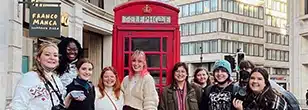How it works
Everything you need to know to obtain the International Experience Canada (IEC) work permit.
Process
Watch a video that explains the process. 90% of our applicants complete the entire process within two months or less. There is the potential for some individual applications to take longer depending on individual circumstances. Please note that we can never guarantee a specific process experience or Government decision timeframe. The following information is all based on the typical participant experience.
1 Sign up and submit the InterExchange application
When you sign up you’ll pay a $100 program deposit that goes toward the balance of your program fee. Once we receive submitted applications, we’ll screen eligibility and contact you typically within 2-3 business days. We’ll provide next steps and guidelines for completing the Government of Canada application.
Please note that the $100 deposit fee is non-refundable if you decide to withdraw from the program. The deposit is refundable if you are not eligible to apply for (see the “Requirements” tab). You can read our refund policy here.
2 Create a profile on the Government of Canada website
We will send you precise guidelines to enter the IEC pool. Do not enter the pool without our instructions (provided after you are accepted to the program).
3 Pay the balance of your program fee
We will send you instructions on how and when to pay. After we receive your profile and program fee balance, you become eligible for nomination nomination. We typically nominate every week on Tuesdays while the program is open, however, please note that delays and extended timelines can occur during the busiest times of the program (typically January and February).
4 Nomination to receive your application documents
- Invitation to Apply (ITA) (this is sent directly from the IRCC)
- R.O. Letter: this is a letter confirming that your participation in Recognized Organization program, which is required for US Citizens. Please note that this letter will arrive from us / separately from the ITA notice.
5 Complete your visa application
6 Submit your visa application fees
You’ll pay a fee of $280 CAD directly to the Canadian government during your visa application.
7 Receive a work permit pre-approval
The pre-approval is also known as a Port of Entry Letter or a Letter of Introduction (LOI). Notify InterExchange as soon as you receive this.
8 Start your pre-departure process
We’ll provide guidance on next steps and accessing info for life adjustments, jobs, and travels in Canada. We’ll hand you off to SWAP Working Holidays, who will be your in-country support! Think of them as your very knowledgeable friend who can help you with all the practical matters regarding life in Canada.
9 Obtain your work permit is at the Canadian border
Present your Work Permit Pre-Approval (LOI) at a Canadian Port of Entry, along with entry documents. (See “Approval” tab on this page for more details).
Requirements
Eligibility
- 18-35 years old
- U.S. citizen (with a current passport with at least 1 year validity)
- Have not participated in IEC twice before (there is a limit of 2 years for IEC for US Citizens).
To start your InterExchange application
- $100 USD non refundable program deposit (that goes toward total program fee)
To Activate Visa / Obtain Work Permit at a Canada Border Port of Entry
- Travel Medical Insurance with coverage validity for one year (or the period of your intended stay in Canada).
- Support funds: at least $2500 CAD in the form of a bank account statement, credit line, or letter of third party support. Most people just show their banking app while at the border.
Documents
Review this information about documents you need for your application. You have the option of preparing some of these ahead of starting the InterExchange or Government of Canada visa application.
Resume
- This does not have to be fancy and can be as plain as a bulleted list. However, you should comprehensively represent your work history with any gaps explained.
- If you have two versions of your resume (for example, for two different industries), you should consider that for just the purposes of submitting the Government application, that you combine the two.
Passport (information page copy)
Your passport must have at least one year of validity on it. When you submit a scan or photo along with your applications, it should be a high quality image that does not obscure any part of the passport and is clear to read (there should be no glare or smudges in your photo).
Visa Photo
Ensure you have a recent visa photo that meets the IRCC specified requirements. Many people take this photo themselves against a white or plain background. You could also choose to go to a copy shop or passport photograph service provider. Just aim for the photo to be as close as you can to a formal passport-style photo.
Police Certificate
Not every application will require a police certificate. The following conditions necessitate a police certificate:
If you have lived outside the U.S. or Canada for six months or more after turning 18, you may need to provide a police certificate from each country you stayed in for a continuous 6+ month period.
See the IRCC website to find out if you need a police certificate and the procedures for obtaining it. The process and timeline for obtaining a Police Certificate varies greatly between each country.
Medical Exam
- Required if you plan to work in eldercare, childcare or a school, or human healthcare.
- May also be needed if you’ve resided in or traveled to health-concern flagged countries. The exam must be performed by a panel physician.
- Note: US Citizens do not need to provide biometrics.
Canada or US criminal background checks
Some 2nd Year IEC participants, or participants continuing from another long term status in Canada, are sometimes asked for the following during their visa application:
- RCMP Criminal Record Check (needs to include fingerprinting!)
- OR FBI Criminal History Summary
- It is recommended to look into the process of both now, just in case one is requested. Please note costs for these documents are not covered or included in your program fee.
Program Orientations
Please participate in a program orientation. Over the years we have found orientations are a positive investment for the applicant/traveler to fully understand their program endeavor!
Participants have 3 options to participate:
Option 1: Overview Orientation typically on every other Wednesday evening. Covers basic application requirements, process, and frequently asked questions.
Option 2: Program Orientation PLUS typically on every other Friday afternoon. This is a great session for those who are first-time travelers outside of the US, or haven’t moved somewhere on their own before! We cover everything in the regular program orientation, plus more cultural information, housing search tips, job market information, and more!
Option 3: 1×1 Meeting. Applicants will be provided 1×1 meeting information upon request.
Costs
Program Fee: $1795
- 2025 Program fee: $1795
- Optional pre-travel job placement service: $295
Included
During your application process, we are here to help you every step of the way. From pre-planning, document checking, and application review, we are here to help you in-depth with one-on-one support. You’ll also receive your RO letter, which will enable you to submit your IEC visa application.
You’ll also have access to SWAP for the duration of your stay in Canada. SWAP services include group orientation, one-on-one consultations, housing search assistance, access to an extensive Canada-wide jobs database, CV and interview preparation, and group social activities (in select cities)!
Not included
- Canadian visa fees ($280 CAD)
- Travel health insurance (Typical plan prices range from $400-1000 USD for 1 year of insurance)
- Travel costs (varies widely depending on destination and duration of travel)
- Personal Support Funds – the equivalent of $2500 CAD upon initial entry to Canada
- Costs incurred for obtaining any documents for your application, e.g. police certificates, background check, or medical exam costs.
Please note that InterExchange is not an immigration specialist or visa service provider. Your payment to InterExchange covers the program fees for InterExchange and SWAP for the items indicated above, but it is up to you to actually obtain the appropriate visa and/or work permit needed for your program. We will provide general information about this process along the way.
Jobs and Travel Support
The Canada WHV is flexible, so you can work on your terms. With SWAP on your side, you’ll have access to an extensive jobs database, with decades of vetted roles with trusted employers in a range of locations.
Get a job placement
For a $295 job placement fee, you can line up a job before you get to Canada.
Work and live one of Canada’s majestic ski mountains: Banff, Jasper, Okanagan, or Whistler. Available roles range from hospitality, resort, hotel, and retail jobs, as well as ski lift operations!
Typically, resort jobs offer on-site employee housing.
Please note, this service is subject to availability and generally placements occur between May and September for a Summer placement, and October through February for Winter placement. If you are pursuing a winter season role it is recommended to apply as early as possible.
Work and travel!
Shorter-term or seasonal work is a great way to experience Canada while making income. In our Orientations, we cover ways you get started on your search. However, the best job-hunting results occur once you have your visa and are in-country. SWAP has a wealth of knowledge and expertise on the job market in Canada, and they’ll be there to help you. Typical jobs include:
- Hospitality/hotels
- Restaurants, cafes, bar work
- Warehouse/factories
- Theme parks
- Special events
- Retail
- Farms
Further your existing career path
Since the WHV is an open work permit, you can also opt to pursue specific, career focused work.
Approval
How do I know when I am approved?
Pre-approval comes in the form of a “Letter of Introduction (LOI)” (aka “Port of Entry Letter”). The LOI expires in one year, so you must enter Canada within one year of obtaining the LOI.
The actual work permit clock begins when you enter Canada at a border port of entry, not when your application is pre-approved/when you receive the LOI. The border officer has the final decision on issuing your work permit. Typically the work permit is issued for one year. If you plan to travel to Canada as a tourist prior to activating your permit this should be fine. Please refer to the government’s information on entering Canada as a visitor.
Before You Travel to Canada
- Gather Required Documents:
- Approval Letter (Letter of Introduction or POE letter)
- US Passport
- Proof of Funds ($2,500 CAD – bank statement or credit line shown on your phone)
- Any other supporting documents from your application.
- Purchase Travel Medical Insurance and bring proof of coverage to the border:
- You must purchase travel medical insurance that covers the full length of your stay. The Canadian border officer will verify your insurance. Work permits will not be issued past your insurance’s validity date.
- Coverage must cover illness, injury, and repatriation.
See more about requirements for arrival. You can look up border information here.
Border Information
Note that the busiest Canada Ports of Entry may have limited hours for immigration services. It is essential that you check the border you are traveling to before you go. See the CBSA’s website.
Car import: If driving into Canada, you may want to consider the import process for your vehicle. Ask us or SWAP if you need guidance on the process.
Flagpoling is defined as exiting Canada and re-entering same day to access immigration services. It is common for visitors or working holiday permit holders to flagpole in order to activate their work permits. As of December 2024, non-US nationalities have restrictions on flagpoling by the Government of Canada. However, US Citizens are exempt from flagpoling restrictions per the Govt of Canada website here where it states:
“In very limited circumstances, work and study permits may still be granted at a port of entry to individuals who otherwise meet the definition of flagpoling. The exemptions include:
– Citizens and lawful Permanent Residents of the United States of America;”
As flagpoling can be viewed as somewhat controversial as these new restrictions are recent, it is recommended to print or have access to the linked article to show to the border officer.
Bringing items into Canada
Customs and Taxes: Double-check any customs or tax rules on bringing items into Canada. For the majority of travelers, this is not applicable. For travelers bringing a pet, see here.
Car Import: If driving a car, you will need to import your vehicle.
You cannot move household items into Canada until you activate your visa. You cannot move household goods into Canada with a visitor status. Attempting to do so may result in being deemed inadmissible at the border.
Additional resources
Government’s Coming to Canada Guide: Review the Government of Canada’s guide for detailed information about entering Canada, work permits, and staying in the country.
Check out the Government of Canada’s publications for newcomers as there may be information useful to you.
Upon Arrival in Canada
- Attend SWAP Orientation:
- Participate in SWAP’s arrival orientation (helps with banking, taxes, housing, etc.).
- Apply for a SIN
- You must apply and activate your SIN before you can start working. You can do this in-person (recommended) or online. SWAP, as your in-country host, are the experts on this!
- Settle In:
- Find housing, set up a bank account, and start exploring your new home!
- Stay Connected with SWAP:
- Reach out to SWAP (via Toronto or Vancouver offices) for any ongoing support.
- Feel free to keep us updated with photos, travel logs, or stories!

Start your Canadian adventure today
Sign up today, and we’ll be in touch about getting you on your way to Canada.














